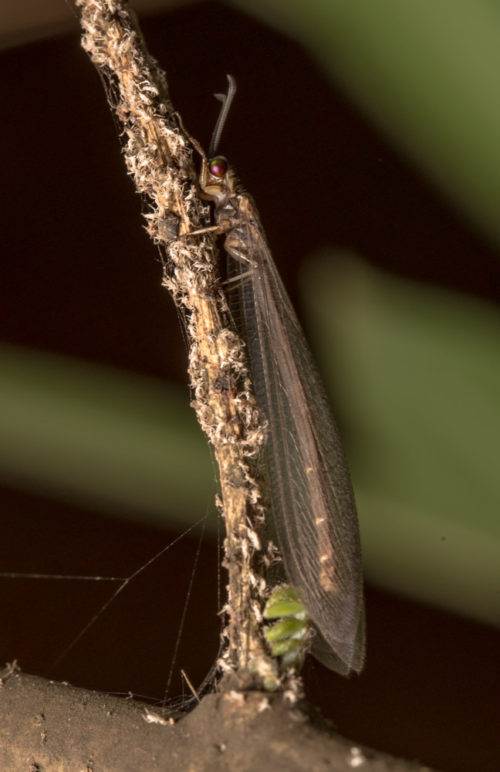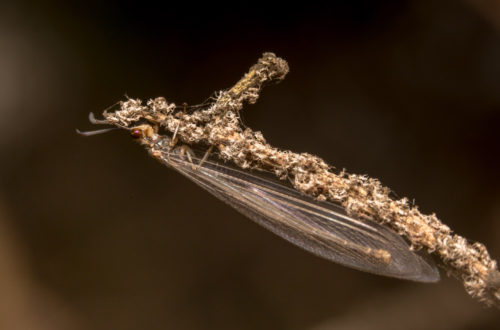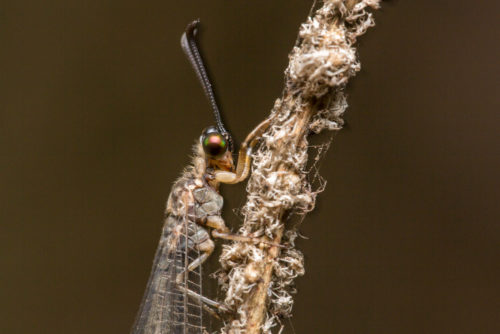
I found this adult Antlion lacewing on an aphid & mealybug ridden Gliricidia sepium branch. The term Ant lion is used to describe the Larval form of the members of this family and the adults are referred to as ‘antgriffins’ or ‘antlion lace wings’. This one belongs to Myrmelion species. I used my Canon EOS 5D Mark III fitted with Canon EF 100mm f/2.8L Macro IS USM, lit by Godox Ving V860c E-TTL Li-ion flash with a LumiQuest SoftBox III diffuser to capture this Antlion lacewing.

Antlions are worldwide in distribution, most common in arid and sandy habitats The ant lion larvae eat small arthropods – mainly ants – while the adults of some species eat small pollen and nectar, while others are predators of small arthropods in their adult stage as well.

Antlions belong to family Myrmeleontidae. The name is rooted in the Greek words myrmex (ant) and leon (lion). The family Myrmeleontidae is part of the order Neuroptera, translated variously as “nerve wings,” “net wings,” or “sinew wings.” All Neuroptera have four wings marked by a netlike pattern of veins. The order Neuroptera, which includes dobsonflies (subfamily Corydalinae) and lacewings (family Chrysopidae), is the most primitive order of insects with complete metamorphosis.

The name “antlion” best describes this insect’s predacious larval form—a mottled gray or brown creature with an oversized head, spiny jaws, short legs, and a soft body covered in bristles. Since it preys primarily on ants, the antlion is, metaphorically speaking, a “lion” among ants. The larvae of some antlion species hide under bits of debris or wood and attack passing insects.
In sandy regions, some species dig a shallow cone-shaped pit and wait at the bottom for an ant or other insect to slip on the loose sand and fall in, only to be immediately devoured. These pit-digging antlions are called “doodlebugs” in the United States because of the designs they make in the sand. As kids we all have fond memory of digging out these antlions from their sandy pits and making them run over our hands. I do remember getting bitten by one large antlion, who gave me quite a painful bite when I mishandled it.

Adult antlions resemble dragonflies or damselflies (order Odonata) and, like damselflies, they are feeble flyers. Antlions are easily distinguished from Odonata by their longer, prominent, clubbed antennae and different type of wing venation. Compared to other Neuroptera (e.g., lacewings), an antlion’s antennae are shorter. The adult is seldom seen in the wild because it is active only in the evening; during the day it rests, motionless, well-camouflaged by its transparent wings and dusk body.

Of the documented relationships between antlions and other animals, perhaps the most interesting is the relationship in which antlion larvae serve as hosts to parasitic insects. For example, the larvae of the Australian horsefly Scaptia muscula live inside antlion larvae pits, where they share the spoils of the antlions’ trapping abilities.

A species of chalcid wasp, Lasiochalcidia igiliensis, is also an antlion parasite. The wasp provokes a host antlion larva into grabbing the parasite’s legs in its mandibles, at which time the parasite oviposits into the membrane between the larva’s head and thorax.

Antlions are often included in lists of beneficial insects, no doubt because they prey upon ants, a common pest to humans.


Very good!